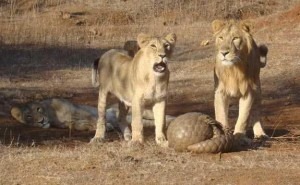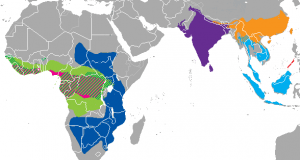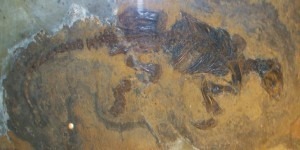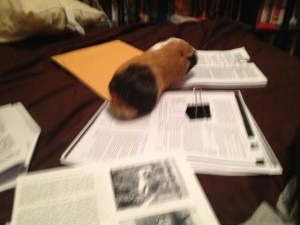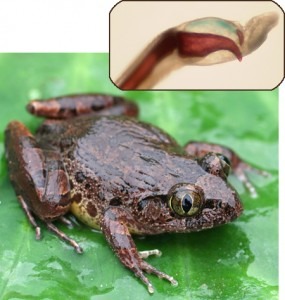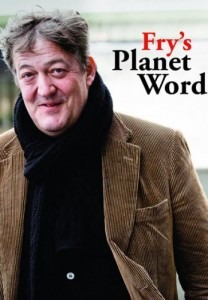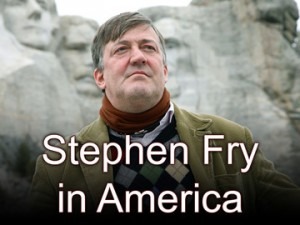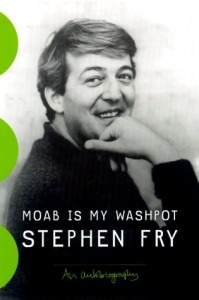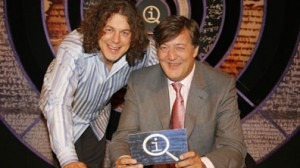Recently a friend of mine posted they had dropped in on their child’s first grade class as the guest reader for the day. He read The Circus Ship by Chris Van Dusen. He mentioned it was one of their favorites so I hopped over to some used book sites to see if we could pick one up.
Continue reading The Circus ShipCategory Archives: Wildlife
Zoobooks
I was talking to a friend about paleoart a couple weeks ago. We were talking about how the first thing you absorb about something is generally what establishes your head canon and makes it hard to change. I realized that a good portion of mine came from two-page spreads in Zoobooks like this one:
Gone to Texas
The conclusion of this painting’s 700 mile 20 year round trip is a fitting end to this series of my work and I feel like my summer projects have been finally completed.
A quick backstory on the painting’s subject in case you are catching up on this at the end: The cotylorhynchus is an early Permian synapsid that was first described by OU’s own J. Willis Stovall in 1937. The species name for the specimen found just north of Norman is Romeri for Alfred Romer (1894-1973), the founder and first president of the Society of Vertebrate Paleontology which now grants the Romer Prize to predoctoral students for work excellence of scientific value and oral presentation at SVP’s annual meeting.
Another loss Reunites Traveling Buddies
At the risk of making this the saddest place on the internet, I have another memorial post for another pet. Five weeks to the day of losing Amelia, we lost our hedgehog Molly. We got her when she was around one year old. The girl that had her had recently gotten a kitten that spent its free time attacked Molly’s cage. She was also a smaller hedgehog with a little crooked nose, she was most likely the runt of a litter.
She lived by herself in a huge cage, but was nice enough to share her space if the need arose–which it did from time to time. She shared her housing with Amelia, the guinea pig that we lost a few weeks ago. They shared the hut all the way from Texas to Oklahoma. After that they would hang out a little from time to time.
 |
| Molly is sleeping in the back as her and Amelia ride out our move. |
Always a happy little hedgehog unless you work her up during the day, then she would grumble, rumble, and curl up. Our dog would always run to where her cage was before we went to bed to tell her good morning and make sure we fed her. Her reaction to losing her was almost as sad as losing Molly.
A few days ago, Molly got sick, we tried to get her feeling better and eventually took an emergency trip to the vet. She was losing weight, slightly dehydrated, and not eating. The Vet gave us some quick weight gain stuff, antibiotics, and a baby food hourly feeling.
 Attentively every hour, I gave her a little baby food with a syringe. She was showing some improvement by 4 yesterday morning, which was worth a little hope. Unfortunately, she was not to recover. I fed her at 11 last night, got her cleaned up from the residual baby food and she smacked down and seemed to like. I was on the couch next to where we had her wrapped up and decided to get her up and see how she was doing. She grumbled a little, but relaxed and let me scratch her belly.
Attentively every hour, I gave her a little baby food with a syringe. She was showing some improvement by 4 yesterday morning, which was worth a little hope. Unfortunately, she was not to recover. I fed her at 11 last night, got her cleaned up from the residual baby food and she smacked down and seemed to like. I was on the couch next to where we had her wrapped up and decided to get her up and see how she was doing. She grumbled a little, but relaxed and let me scratch her belly.
She was on my chest when she stopped breathing. It took awhile to be able to go upstairs and wake up my wife. Our dog had to get on the couch and look into the little box where we had put her. Her reaction delayed us leaving for a few more minutes. So, in the middle of the night, we took her and laid her to rest next to her traveling companion.
Another tale of a rescued pet living out its life with us in comfort that is not meant to sadden but to reflect on what small pets can mean to people. It is especially difficult when you work so hard to help them get better, only to have them not make it. Being there when life disappears from a body, has been the one thing that I have never hardened myself to. But, I was with her until the end and she was comfortable, which I guess is the best you can hope for in such a situation. She was resting peacefully when she died, and I hope that she will continue to be so.
Hopefully, Molly’s passing will be the last one for a while, another problem we have is that most of our small mammals are the same age, so they will all be getting old and infirm at the same time. Most of them probably wouldn’t have lived as long as they have elsewhere, but that is little comfort when they do pass.
That being said, don’t get small pets to teach children responsibility, give them chores or a job, or something. For some they are just pets, expendable, exchangeable. But for us, they are a part of us, a part of life, and when that life is extinguished, by illness or old age, there is an unspeakable loss that logical thinking deems silly, but emotional responses claim otherwise.
I cannot express how physically, mentally, and emotionally exhausted I am. My wife went in to teach her class today and I went in to work for a bit, but this has been taxing on both of us. Knowing she is with Amelia is about as much comfort as we have–and that is better than none. Definitely makes one think about what Hope was doing in Pandora’s box with all those other horrible things—to have it and have it shattered–is that worse than not having any at all? At the time, maybe not, but it’s still painful–and there are so many cute pictures of happy hedgehogs that go around facebook, it’s going to hard to avoid.
Pangolins: The Armored Among Us
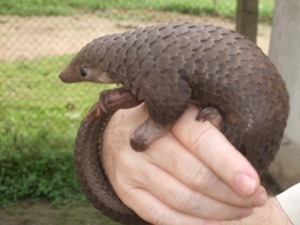
Any time a documentary or nature channel wants to show viewers how weird nature can be the pangolin is bound to make an appearance. The only mammal with scales always shows up in an extreme mammal montage complete with requisite cute video of them rolling into a ball to protect itself.
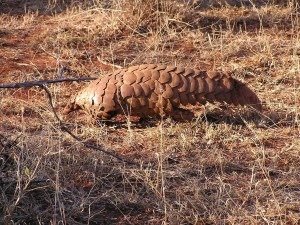
As usual, there is more to the story than that. The 8 species of “scaly anteaters” are equally distributed across the tropics with 4 species in Africa–The Cape of Temminck”s ground pangoling (Manis temminckii), Tree of African white-bellied pangolin (Phataginus tricuspis), Giant Ground pangolin (Smutsia gigantea), and the Long-tailed or black bellied pangolin (Uromanis tetradactyla)
and 4 in Asia–Indian or thick tailed pangolin (Manis crassicaudata), Chinese or Formosan pangolin (Manis pentadactyla), Malayan or Sunda pangolin (Manis javanica), and the Palawan or Phillippine pangolin (Manis culionensis). Some are arboreal, most are nocturnal, and nearly all are endangered. The terrestrial ones live in burrows that reach 11 feet (3.5 meters) in depth.Lacking teeth, the use their powerful claws to rip open termite dan ant mounds to get at the delicate insect morsels inside. The trouble is, people are doing the same thing to the Pangolins.
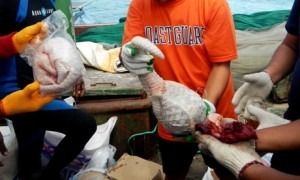 A few weeks ago, a Chinese vessel that had crashed into a reef of the Philippines was discovered to have more than 10,000kg of pangolin meat. The Guardian published the article on April 15. Subsequent poachers have been caught in Vietnam, Thailand, and India.
A few weeks ago, a Chinese vessel that had crashed into a reef of the Philippines was discovered to have more than 10,000kg of pangolin meat. The Guardian published the article on April 15. Subsequent poachers have been caught in Vietnam, Thailand, and India.
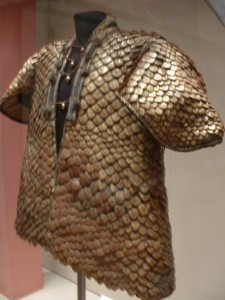 The desire for pangolin scales and/or meat is not a new phenomenon. Back in 1820, King George III was presented with this pangolin scale shirt.
The desire for pangolin scales and/or meat is not a new phenomenon. Back in 1820, King George III was presented with this pangolin scale shirt.
Their scales are made of keratin, the same substance as human hair and rhinoceros horn. Their scales along make up about 20% of their body weight, which depending on species can range from 30-40 pounds (~13.6-18kg)
Every part of the pangolin is in demand. They are hunted mainly for meat, jewelry, and–you guessed it–traditional chinese medicine. The only hard facts that anyone has about the illegal pangolin trade is that it is happening on an alarming, almost incomprehensible scale.
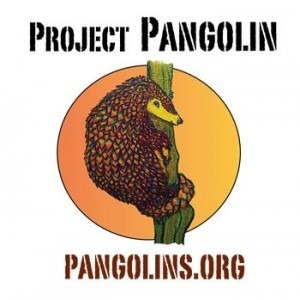 Today groups like the Project Pangolin are working tirelessly to raise awareness of these endangered animals. If not the most often poached and smuggled wildlife, they are at least near the top of the list. If you are on facebook you can like Project Pangolin’s page, and get updates on your home feed. It’s not all doom and gloom, they share some really great images of pangolins and of the people that work to help end the threat to these guys.
Today groups like the Project Pangolin are working tirelessly to raise awareness of these endangered animals. If not the most often poached and smuggled wildlife, they are at least near the top of the list. If you are on facebook you can like Project Pangolin’s page, and get updates on your home feed. It’s not all doom and gloom, they share some really great images of pangolins and of the people that work to help end the threat to these guys.  They are being killed faster than they can reproduce. Their gestation ranges from 60 days in some species to
They are being killed faster than they can reproduce. Their gestation ranges from 60 days in some species to
over twice that long in others (139 days). They usually have one pangopup (yes, that is really what they are called) although some Asian species can have 2 or 3. They are about 6 inches (15 cm) at birth and weigh about 3/4 of a pound. (12 ounces or so). Their scales are soft, but will harden by their second day. They are mammals, so the babies nurse. They can eat termites and ants after a month, but usually nurse for three or four. Just like their larger cousins, these little anteaters carry their pups on their backs, where the coloration can help camouflage the infant. As long as the baby is small enough, the mother will roll up around it if there is danger.
Birds on Fire and the Final Word from Levon Helm
I don’t know what I ever wanted this collection of thoughts to ever become, but I find myself saying that some things I think about writing on don’t fit my “theme.” Honestly, until I have that discussion in my head I never really think of even having a theme. In fact I have another blog that is random ramblings that specifically have no theme–and I don’t regularly update that one either.
There is a documentary coming out about a member of one of the most influential bands in the history of music–The Band–and at the end of the trailer is a brief clip of him talking about the platypus. So, I thought there–nonexistent theme be damned I am collecting three trailers of things coming out that are entirely unrelated to any semblance of theme, and sharing them.
First up is a documentary covering the life of Aldo Leopold. For those who think that name sounds familiar it is either because you have read “Thinking Like a Mountain” written by Leopold, or you are confusing it with the Hugh Jackman movie Kate and Leopold. This is a documentary about the former. One of the most striking things is the explanation regarding how Leopold’s work is still relevant because he was so far ahead of his time. Even some modern ideas are behind some of Leopold’s writings from the 1930s. You can see the Green Fire trailer here.
Requiem for a Friend
“You can easily judge the character of a man by how he treats those who can do nothing for him.”–Goethe
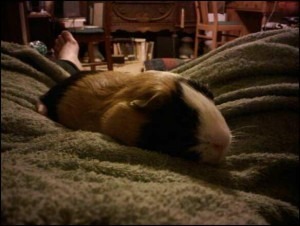 Today we buried out pet. With that in mind I would like to spend some time remembering. This generally would seem overly attached or perhaps idiosyncratic, but writing gets it out. That is not to say it empties what is inside, but it distributes in a manner than is easier to handle, at least for me.
Today we buried out pet. With that in mind I would like to spend some time remembering. This generally would seem overly attached or perhaps idiosyncratic, but writing gets it out. That is not to say it empties what is inside, but it distributes in a manner than is easier to handle, at least for me.
The gamut runs from people who do not have pets, through people who see them as things, objects, watchdogs, etc., all the way through people who leave everything to them in their will. Most, if not all in these latter cases are dogs or cats. Little attention is paid to smaller mammals whose life expectancy fortuitously aligns itself with the age of a child that wants a pet until the age that child has better things to do. This is s story of the latter.
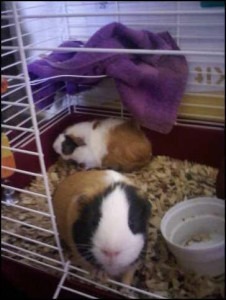 Amelia Earhart was an adoption. A full grown cavy when it arrived at our home. His name was Lilly. We didn’t bother to check the sex, but weren’t happy with the name Lilly so, since (s)he was red we decided on Amelia Earhart. My wife and I were not yet married and where we were staying did not allow dogs or cats, but small animals in cages were okay. We had been together for 2 years and this was our first pet together.
Amelia Earhart was an adoption. A full grown cavy when it arrived at our home. His name was Lilly. We didn’t bother to check the sex, but weren’t happy with the name Lilly so, since (s)he was red we decided on Amelia Earhart. My wife and I were not yet married and where we were staying did not allow dogs or cats, but small animals in cages were okay. We had been together for 2 years and this was our first pet together.
Alas, cavy’s are social creatures by nature so we went looking for at least a friend that Amelia could share the hours we weren’t home with. We adopted a neutered male. We did the little introduction days and they fought every time. That is when we double checked and found out Amelia was a male. Now we had two singular pigs that needed friends (you can see where this gets quickly expanded) Eventually Amelia and Fred Noonan had one piglet that we named Baby Lindbergh. (sense the theme?)
Amelia was the mellowest of all the cavies we had and enjoyed A LOT of out-of-cage time, mostly with me in the chair when not running around the apartment. Throughout long hours of writing and editing my master’s thesis the pig was with me sorting papers, finding citations, discarding articles, chewing on articles (him not me) and just being another awake soul in the house. He would sit in my lap as I read, and if I had the time to scratch him he would groom my arm, or my beard if he was perched on my shoulder, which happened as often as he liked.

We moved to Oklahoma so I could get a PhD at the University of Oklahoma and brought most of our pets along. Most of the reptiles stayed with the science lab where my wife had taught. Amelia made the 8 hour trip sharing lodging with Molly our hedgehog, and was as content as ever.
Once we were settled in Norman, we decide to go ahead and get Amelia fixed so he could go back in the cafe with Fred and Baby. First trip in they found a hole in his abdomen. Rounds of antibiotics later he was back to his usual leafy green eating self. We finally succeeded in scheduling and having his surgery a few weeks ago. They said he was getting cataracts and was a fairly old pig. We have had him for about 3 and a half years and being full grown (1 and a half or 2) he was getting to the end of an expected lifecycle.
About a week after his surgery his lower GI became impacted and we had to take him back and get him unclogged. They said he was probably sore from the surgery and that it would get better. It didn’t. Turns out he had a hernia that needed fixed. We didn’t know this until we got back to our vet after she came back from her vacation.
Turns out the poor guy had a hernia and an abscess as well that had attached to everything. Through all this he had a hole in his intestines. (turns out the abscess saved him for a while since it attached to the intestine at the hole and sealed it, preventing leakage into the abdominal cavity)
They worked on Amelia for three hours and got everything out. The vet was sure he wouldn’t survive surgery, but we were able to go in an see him when he woke up. She couldn’t believe it. We stayed with him until the vet’s office closed, holding him in their yellow blanket. He was a little drowsy but otherwise moving and doing guinea pig stuff. She said he was the most resilient pig she had ever seen.

The fight through recovery was more than the old fellow could manage though, and he passed away this morning (April 3, 2013). To say that it was a blow would be an understatement, but to admit we hadn’t figured as much would be untrue. We could have brought him home, but the facilities at the vet’s office were warmer and more comfortable to him, and the weather here has been atrocious for three days cold and wind, so we left him in his little warm cage there. Sad that he did not get to die at home, but knowing he was warm and comfortable, and had went to sleep after eating a little and exploring his cage is some consolation.
I grew up on a farm in a rural community and have been surrounded by death all my life–people and animals. If you see them as living beings you never really get used to such a loss. I study history and paleontology so I work intimately with dead people and dead things. This is nothing new to me, but the loss is, for the lack of a better word, heartbreaking. Many people would just replace a lost pet or not depending on mood, and we have other pigs, Fred ad Baby and a few others, but we wouldn’t have stopped at the pet store to get another one if we hadn’t.
 There seems to be a hierarchy of pets, at least presented by those selling, or by general consensus. Somehow small mammals with short lifespans are less pet to interact with and get attached to than a dog, cat, horse, birds, etc. That is only true if you put them away in a room and only interact with them at feeding time. Otherwise they leave just as wide a hole in your life when they are gone as others.
There seems to be a hierarchy of pets, at least presented by those selling, or by general consensus. Somehow small mammals with short lifespans are less pet to interact with and get attached to than a dog, cat, horse, birds, etc. That is only true if you put them away in a room and only interact with them at feeding time. Otherwise they leave just as wide a hole in your life when they are gone as others.
Today we buried my friend. The finality of that was incredible. I have sobbed uncontrollably a few times today, and teared up more times than I can count. The takedown of his home was just as bad and leaving him under the oak trees. I have dealt with each step with varying degrees of success, and I have written this through tears.
A grown man has cried all day over the death of a small house pet. And I probably will continue to do so for a few days, probably more. Time will pass, and the weeping will occur less and less, but that doesn’t mean I have forgotten. I don’t know what the equation is for hurting at death vs. enjoyment in life, but I know that the greater the enjoyment and happier the memories the greater the sense of loss. We did everything we could to help our pig, and more than most probably would.
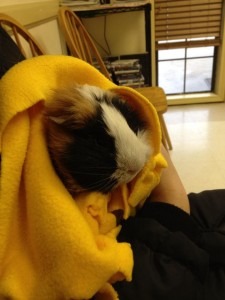 This is not the first rescue pet that we have lost. Taking in other people’s unwanted and usually mistreated animals always makes a dicey situation for how long they will remain with us, but each has ended their life in greater comfort and love than they began it, that I hope accounts for something. The vet learned some things from working on Amelia that I hope will help in future situations. Guinea pigs as a the colloquial test subjects have done so much for the human race–more than we could ever repay even if everyone wanted to–which they don’t.
This is not the first rescue pet that we have lost. Taking in other people’s unwanted and usually mistreated animals always makes a dicey situation for how long they will remain with us, but each has ended their life in greater comfort and love than they began it, that I hope accounts for something. The vet learned some things from working on Amelia that I hope will help in future situations. Guinea pigs as a the colloquial test subjects have done so much for the human race–more than we could ever repay even if everyone wanted to–which they don’t.
I have no regrets with the life that we gave Amelia, I am not using this as a sounding board that I hope he reads and understands how much we miss him or any anthropomorphic existential thing like that. He knew, or felt, or existed in as much love as a household could manage to give. That is the best way for it to be, I think.
I am so very sad that he is no longer with us, but I am that much more happy that we shared most of his life with him. For every tear we have shed today there were 10 times he made us laugh and 100 times he made us smile. He had nothing to offer us and somehow gave us more love than we could return.
Art Imitates Nature
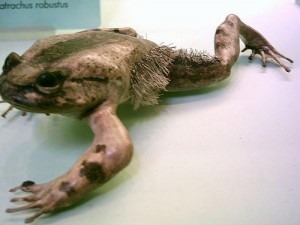 |
| The Hairy Frog from Central Africa |
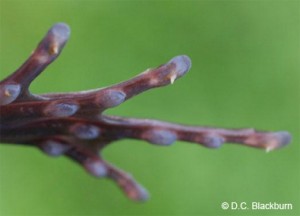 |
| The broken bones protrude through the tips of the finger pads |
 |
| When annoyed the newt moves its ribs forward |
 |
| tomography shows the sharp points on the ribs |
 |
| The poisonous secretion that coat the rib tips |
 |
| poisonous rob barbs sticking through to discourage even the hungriest of predators |
My Summer of Stephen
The summer is coming to a close, for me at least. I have (officially) completed my Master’s Thesis in History studying the History of American Conservation via the National Zoological Park in Washington, D.C., USA. I also begin my next course of study at the University of Oklahoma in the History of Science, specifically the history of Museum Collecting, and more specific than that, hunting for museums, and fossil expeditions.
 I completed the writing portion of my graduate studies back in March. Edits and bureaucratic fecalities took a toll to generously allow me to only graduate this coming Aug. 18. In between correspondence and moving I took up my reading list. I had set out to make 2012 the year of the biography, with ideas of reading about individuals that I looked up to or respected as professionals in their field. I suppose “heroes” is as good a word as any. I ended up following a narrative thread through one individual much farther than I had intended. That individual is Stephen Fry.
I completed the writing portion of my graduate studies back in March. Edits and bureaucratic fecalities took a toll to generously allow me to only graduate this coming Aug. 18. In between correspondence and moving I took up my reading list. I had set out to make 2012 the year of the biography, with ideas of reading about individuals that I looked up to or respected as professionals in their field. I suppose “heroes” is as good a word as any. I ended up following a narrative thread through one individual much farther than I had intended. That individual is Stephen Fry.
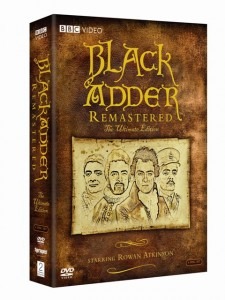 I have been aware of Stephen Fry for many years, mainly as one of England’s “national treasures.” I began to follow his works and words with more intensity when he released a documentary called Last Chance to See with Mark Carwardine. Fry as cohost and non-naturalist brought a child like wonder to the natural world that I have not seen in many years. Further research indicated that Carwardine contacted Fry to reprise Douglas Adams’ role int he original Last Chance to See. Fitting, given Stephen and Douglas were great friends in life. Incidentally there is an hour long reading where Douglas recounts some of the original travelogue. Poisonous snakes and antivenom are the highlights.
I have been aware of Stephen Fry for many years, mainly as one of England’s “national treasures.” I began to follow his works and words with more intensity when he released a documentary called Last Chance to See with Mark Carwardine. Fry as cohost and non-naturalist brought a child like wonder to the natural world that I have not seen in many years. Further research indicated that Carwardine contacted Fry to reprise Douglas Adams’ role int he original Last Chance to See. Fitting, given Stephen and Douglas were great friends in life. Incidentally there is an hour long reading where Douglas recounts some of the original travelogue. Poisonous snakes and antivenom are the highlights.
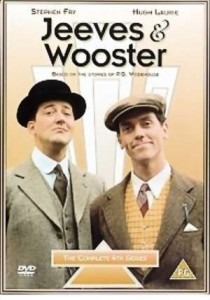
 Back to Fry. Working backwards from Last Chance to See I began to find Fry nearly everywhere. I absorbed the series A Bit of Fry and Laurie, Jeeves and Wooster, his works in Blackadder, and even joined twitter for the shear joy of reading Fry’s tweets. I followed his English Cab across the United States in Stephen Fry in America and followed the depths of depression and mania in his Secret Life of the Manic Depressive. He hosted a one off on Gutenberg and the Printing Press, another which I finally watched last night on Wagner, and the brilliantly executed Planet Word. Stephen Fry and Brian Blessed, quite worth seeing. Even though Fry only wrote the preface/introduction to the accompanying Planet Word Book, it is still worth a read. As I am writing this I am watching his interview on Bigthink.com, and Fry and Laurie Reunited.
Back to Fry. Working backwards from Last Chance to See I began to find Fry nearly everywhere. I absorbed the series A Bit of Fry and Laurie, Jeeves and Wooster, his works in Blackadder, and even joined twitter for the shear joy of reading Fry’s tweets. I followed his English Cab across the United States in Stephen Fry in America and followed the depths of depression and mania in his Secret Life of the Manic Depressive. He hosted a one off on Gutenberg and the Printing Press, another which I finally watched last night on Wagner, and the brilliantly executed Planet Word. Stephen Fry and Brian Blessed, quite worth seeing. Even though Fry only wrote the preface/introduction to the accompanying Planet Word Book, it is still worth a read. As I am writing this I am watching his interview on Bigthink.com, and Fry and Laurie Reunited.
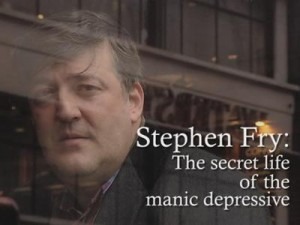 Working on a Master’s thesis quite limits the amount of things that you can read outside of your chosen research topic. I did however want to read his two autobiographies, badly. I have always enjoyed biographies, autobiographies and memoirs more than any other type of literature. They are the windows into the minds and sometimes souls of people that you want to emulate, or most definitely not emulate as the case may be. They are what can connect “common” people with those that are “famous.”
Working on a Master’s thesis quite limits the amount of things that you can read outside of your chosen research topic. I did however want to read his two autobiographies, badly. I have always enjoyed biographies, autobiographies and memoirs more than any other type of literature. They are the windows into the minds and sometimes souls of people that you want to emulate, or most definitely not emulate as the case may be. They are what can connect “common” people with those that are “famous.” I picked up both Moab is My Washpot and the more
I picked up both Moab is My Washpot and the more
recent Stephen Fry Chronicles with all intent of reading them. I ended up getting them on audiobook and listening to them both as I drove the length of Texas multiple times in order to find a place to live, a job, and other amenities in Norman, OK. Let me back up a bit. I hate–HATE books on tape. I suppose they are just called audiobooks now, but the point remains valid: I hate having someone read a book to me, they never put he emphasis where I think it should be, or where I would have put it had I been reading it myself. But, I bit the bullet and decided that the 8 hour drive would be better spent listening to books on my “To Read” list than scanning 236 radio stations or listening to 37 Dire Straits repeats on my ipod.
Luckily for me Stephen Fry also read these books. This is an acceptable substitute in my mind, after all, who else better qualified to read a book, besides the author? I was not disappointed. Gaining an insight into what make Fry tick, his troubles with addiction and acceptance were extremely interesting. The mundane details of boarding school and public school life were also of interest to someone raised in the United States. Chronicles ends just before A Bit of Fry and Laurie takes off. I hope that there is another work in progress picking up where that one left off. How great would it be if Hugh Laurie would get on the wagon and write his own. Doubtful, though, given how private Hugh keeps his life.

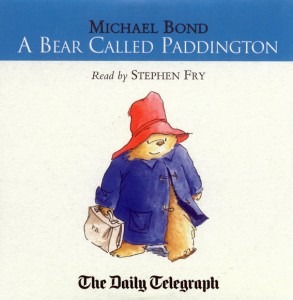 I picked up two more audio treats as well. Stephen Fry’s English Delight and Rescuing the Spectacled Bear. The former follows some of the more intricate and completely obtuse evolution of the English language. The latter is a Peruvian diary followup to A Bear Called Paddington. Which everyone should read, similar to the story of Winnie the Pooh or Smokey the Bear, Paddington is the “face” of a species. A species that is in ever growing danger of extinction. Rescuing is also a neat little aside into Peruvian political and natural history.
I picked up two more audio treats as well. Stephen Fry’s English Delight and Rescuing the Spectacled Bear. The former follows some of the more intricate and completely obtuse evolution of the English language. The latter is a Peruvian diary followup to A Bear Called Paddington. Which everyone should read, similar to the story of Winnie the Pooh or Smokey the Bear, Paddington is the “face” of a species. A species that is in ever growing danger of extinction. Rescuing is also a neat little aside into Peruvian political and natural history.
My latest addiction as it were has been the show QI. Stephen hosts the show with comedian Alan Davies in a perpetual Ed McMahon role receiving pointed barbs from Stephen throughout the show. When the show was first marketed I thought it was simply a game show, and armed with that knowledge I vowed never to watch it. I hate game shows with almost the same fierceness as I loathe books on tape. With all the work before me in graduate school it was easy to ignore it. The downside is that I missed a lot of brilliant banter in real time. The upside is that I know have 8 seasons or so to catch up on.
Somehow I came across a youtube clip of the “best of” QI in which they were discussing the giant tortoise and eventually what it is “they say at the acropolis where the parthenon is…”(if you google that you should find a great video.) That would be a perfect way to end. However I must confess one small thing at this point, I have not yet read any of Stephen’s fiction. Although I hear it is well received, I haven’t actually read any fiction in probably two years or so. Well, that may not be entirely true, we listened to Jurassic Park on one of the trips to or from Oklahoma, and I devoured Gideon Defoe’s Pirates! in an Adventure with Scientist before the Aardman production was released.
The Mighty Nimrod
 Frederick Courtney Selous is a name synonymous with hunting, adventure, conservation, and Africa. At least in some circles, that is. Born in 1851 in Regent’s Park, London Selous became one of the greatest white sons of Africa. His life epitomizes that of the regal English birth, with his father one time chairman of the London Stock Exchange and his mother a published poet. The family was in all ways quite well off, but he felt the call of the Dark Continent at the age of 19. He would travel back and forth from Africa to London to attend to business and family matters as well as meet at the Shikar Club which he co-founded in 1909. For all other considerations he lived, worked, studied, and died in Africa. His brother, Edmund, became a noted ornithologist and poet, in fact many of Frederick Selous’ poems and collected works reveal a depth of character that many take for granted. Selous loved Natural History and exploration from a young age and studied any living thing that he could. During his expeditions and hunting safaris he collected many of the first specimens to come out of places such as Namibia and Sudan. He also hunted big game across Europe and North America, but he will always be remembered as Africa’s Great White Hunter.
Frederick Courtney Selous is a name synonymous with hunting, adventure, conservation, and Africa. At least in some circles, that is. Born in 1851 in Regent’s Park, London Selous became one of the greatest white sons of Africa. His life epitomizes that of the regal English birth, with his father one time chairman of the London Stock Exchange and his mother a published poet. The family was in all ways quite well off, but he felt the call of the Dark Continent at the age of 19. He would travel back and forth from Africa to London to attend to business and family matters as well as meet at the Shikar Club which he co-founded in 1909. For all other considerations he lived, worked, studied, and died in Africa. His brother, Edmund, became a noted ornithologist and poet, in fact many of Frederick Selous’ poems and collected works reveal a depth of character that many take for granted. Selous loved Natural History and exploration from a young age and studied any living thing that he could. During his expeditions and hunting safaris he collected many of the first specimens to come out of places such as Namibia and Sudan. He also hunted big game across Europe and North America, but he will always be remembered as Africa’s Great White Hunter.
 More than this and more than being the nebulous grandfather to Indiana Jones, Selous was one of the world’s first conservationist. His motives may not have been as pure as today’s, but the influence is still there nonetheless. In 1881 he noted that elephants were growing more scarce south of the Zambezi River. The decline was so serious that it had become impossible to make a living hunting the area. A testament to his planting of conservationist seeds, the Selous Game Reserve in southeastern Tanzania is named in his honor. The area was originally established as an unnamed hunting reserve in 1905, but due to the swarms of tsetse flies humans rarely took the opportunity. Fighting in the First World War on an advance against a German force outnumbering his men five to one Selous took his field glasses to look over a protective embankment and was killed on January 4, 1917 by a German sniper’s bullet. He was buried under a nearby tree in part of that original game reserve that would bear his name five years later. Sixty-five years after his death the reserve was designated a UNESCO world heritage site. The world could now celebrate the diversity of wildlife and undisturbed nature that Selous had enjoyed all his life.
More than this and more than being the nebulous grandfather to Indiana Jones, Selous was one of the world’s first conservationist. His motives may not have been as pure as today’s, but the influence is still there nonetheless. In 1881 he noted that elephants were growing more scarce south of the Zambezi River. The decline was so serious that it had become impossible to make a living hunting the area. A testament to his planting of conservationist seeds, the Selous Game Reserve in southeastern Tanzania is named in his honor. The area was originally established as an unnamed hunting reserve in 1905, but due to the swarms of tsetse flies humans rarely took the opportunity. Fighting in the First World War on an advance against a German force outnumbering his men five to one Selous took his field glasses to look over a protective embankment and was killed on January 4, 1917 by a German sniper’s bullet. He was buried under a nearby tree in part of that original game reserve that would bear his name five years later. Sixty-five years after his death the reserve was designated a UNESCO world heritage site. The world could now celebrate the diversity of wildlife and undisturbed nature that Selous had enjoyed all his life.
 Nimrod was the mighty hunter in the book of Genesis, and some legends will cite him as the source of the Tower of Babel. Whose to say, there are references to The Mighty Nimrod all over the Ancient World. The moniker works for Selous only in the hunting aspect of things. However, Selous did have many powerful and prominent men as friends. Among them he counted American president Theodore Roosevelt, The world traveling adventurer/scout Frederick Russell Burnham (also known as “The King of Scouts” and “he-who-sees-in-the-dark), and the wealthy if not likes Cecil Rhodes.
Nimrod was the mighty hunter in the book of Genesis, and some legends will cite him as the source of the Tower of Babel. Whose to say, there are references to The Mighty Nimrod all over the Ancient World. The moniker works for Selous only in the hunting aspect of things. However, Selous did have many powerful and prominent men as friends. Among them he counted American president Theodore Roosevelt, The world traveling adventurer/scout Frederick Russell Burnham (also known as “The King of Scouts” and “he-who-sees-in-the-dark), and the wealthy if not likes Cecil Rhodes.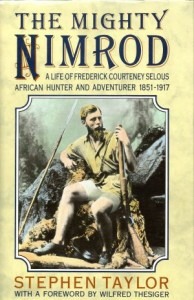 Selous aided Roosevelt’s post-presidency safari, although it was officially led by R. J. Cunninghame. Burnham fought in many of the United State’s Indian wars, and, under the belief that the west was growing too tame for his taste took his talents to Africa. Rhodes, had more money than God and always managed to piss off the locals. Who knows what Selous thought of Rhodes ethnographic designs, but the two went about their own business and upon his death Rhodes left a substantial fund of scholarship for specific individuals the world knows today as Rhodes Scholars. He also left land to the South African country near Table Mountain that became the University of Cape Town and the other part becoming the Kirstenbosch National Botanical Garden. Perhaps Rhodes was the tower building Nimrod to Selous’ hunting one. There numerous books on Selous, including many written himself, but for a one shot wonder, I recommend The Mighty Nimrod by Stephen Taylor.
Selous aided Roosevelt’s post-presidency safari, although it was officially led by R. J. Cunninghame. Burnham fought in many of the United State’s Indian wars, and, under the belief that the west was growing too tame for his taste took his talents to Africa. Rhodes, had more money than God and always managed to piss off the locals. Who knows what Selous thought of Rhodes ethnographic designs, but the two went about their own business and upon his death Rhodes left a substantial fund of scholarship for specific individuals the world knows today as Rhodes Scholars. He also left land to the South African country near Table Mountain that became the University of Cape Town and the other part becoming the Kirstenbosch National Botanical Garden. Perhaps Rhodes was the tower building Nimrod to Selous’ hunting one. There numerous books on Selous, including many written himself, but for a one shot wonder, I recommend The Mighty Nimrod by Stephen Taylor.







